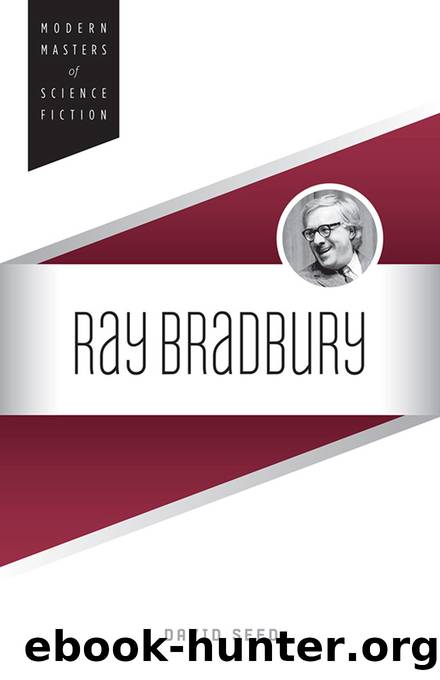Ray Bradbury by David Seed

Author:David Seed
Language: eng
Format: epub
Publisher: University of Illinois Press
Published: 2015-02-15T00:00:00+00:00
PASTORAL APOCALYPSE
In Fahrenheit 451, Bradbury removes Montag from the city, which is emblematic of the regime, to an alternative rural landscape. Indeed, the last phase of the novel replaces quasirealist narration with a symbolic sequence of scenes suggesting rebirth. Montag crosses a river into a new life; after his âexecutionâ on TV, he is welcomed âback from the deadâ by the Book People. The significance of the phoenixâs regenerative life cycle is now made explicit.75 Throughout Fahrenheit 451, Bradbury has insistently linked books, birds, and people. It is therefore consistent with this symbolism that in the last section of the novel people should become books. Collectively, the Book People represent a metaphor made flesh. As Eller and Touponce have rightly pointed out, the Book People imply a notion of textual production, which continues from authors to readers in an open-ended continuum.76 Even more importantly, they enact the reappropriation of language and the reconstitution of memory common to dystopian misfits and rebels.77 Geoffrey Hartman has argued cogently that the exclusion of authorsâ and readersâ names alike âshows what ideally happens in the act of reading: if there is a sacrifice to the exemplary, it involves the aggrandizement neither of author nor of reader but leads into the recognition that something worthy of perpetuation has occurred.â78
It is an important detail that Montag should be welcomed into the group by Granger, whose name recalls the populist movement of the 1860s and 1870s, dedicated to improving the lot of U.S. farmers. Like them, the Book People are rural, anticentralist, and loosely communitarian. Montagâs first encounter around a campfire recalls the imagery of one of Bradburyâs favorite novelsâThe Grapes of Wrathâand suggests that the movement reflects a populist response to hardship. As Granger explains to Montag, the movement took place spontaneously: âthousands on the roads, the abandoned railtracks, tonight, bums on the outside, libraries inside . . . over a period of twenty years or so, we met each other, traveling, and got the loose network together and set out a planâ (146). The evocation of hobo camps carries historical resonances with the 1930s and through a âmetaphoric time-travel,â while Montag recaptures lost childhood memories like the scent of leaves.79 Though referenced through the past, these fireside discussions represent an unmediated communication lost in the dystopian world of the novel. Despite the consistency of this fire motif, John Huntington has argued that Bradbury ignores the implications of his âidealized hobo mystique,â never considering the hardship that could lie behind the Book Peopleâs lives or the possibility that books themselves may have contributed to the novelâs dystopian present.80 In that respect Bradburyâs allusions to history are selective in being heavily determined by the needs of his symbolic polarities.
The multiple meanings of fire, so central to Fahrenheit 451, are also exploited, more austerely, in Walter M. Millerâs 1959 novel A Canticle for Leibowitz. Here, a massive nuclear war, mythologized as the âFlame Deluge,â brings about a rupture in Western culture, and the novel retraces history as a rediscovery of technology, which ultimately leads to yet another nuclear war.
Download
This site does not store any files on its server. We only index and link to content provided by other sites. Please contact the content providers to delete copyright contents if any and email us, we'll remove relevant links or contents immediately.
The Power of Myth by Joseph Campbell & Bill Moyers(1002)
Half Moon Bay by Jonathan Kellerman & Jesse Kellerman(953)
A Social History of the Media by Peter Burke & Peter Burke(935)
Inseparable by Emma Donoghue(922)
The Nets of Modernism: Henry James, Virginia Woolf, James Joyce, and Sigmund Freud by Maud Ellmann(833)
The Spike by Mark Humphries;(765)
The Complete Correspondence 1928-1940 by Theodor W. Adorno & Walter Benjamin(746)
A Theory of Narrative Drawing by Simon Grennan(742)
Culture by Terry Eagleton(713)
Ideology by Eagleton Terry;(696)
Bodies from the Library 3 by Tony Medawar(680)
World Philology by(674)
Farnsworth's Classical English Rhetoric by Ward Farnsworth(673)
Game of Thrones and Philosophy by William Irwin(669)
High Albania by M. Edith Durham(654)
Adam Smith by Jonathan Conlin(648)
A Reader’s Companion to J. D. Salinger’s The Catcher in the Rye by Peter Beidler(646)
Comic Genius: Portraits of Funny People by(616)
Monkey King by Wu Cheng'en(609)
